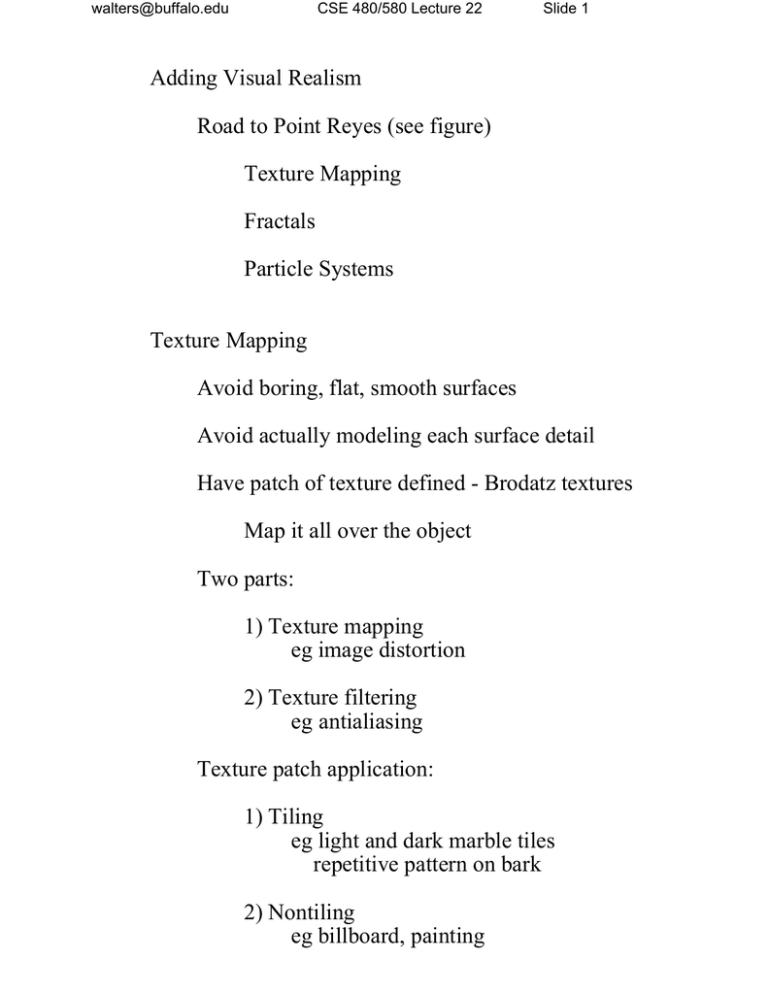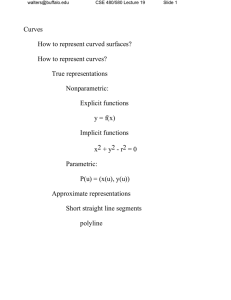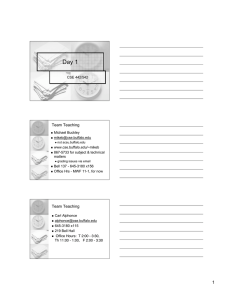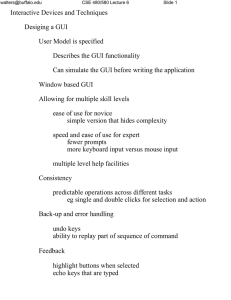Adding Visual Realism Road to Point Reyes (see figure) Texture Mapping Fractals
advertisement

walters@buffalo.edu CSE 480/580 Lecture 22 Slide 1 Adding Visual Realism Road to Point Reyes (see figure) Texture Mapping Fractals Particle Systems Texture Mapping Avoid boring, flat, smooth surfaces Avoid actually modeling each surface detail Have patch of texture defined - Brodatz textures Map it all over the object Two parts: 1) Texture mapping eg image distortion 2) Texture filtering eg antialiasing Texture patch application: 1) Tiling eg light and dark marble tiles repetitive pattern on bark 2) Nontiling eg billboard, painting walters@buffalo.edu Texture Space: (s, t) Array Coordinates CSE 480/580 Lecture 22 Object Space: (u,v) Surface Parameters Texture-Surface Transformation Slide 2 Image Space: (x,y) Pixel Coordinates Viewing and Projection Transformation Can do texture mapping in either direction: 1) texture scanning texture space to object space to image space 2) pixel-order scanning image space to object space to texture space Texture to object space parametric linear functions u = a us + b ut + c u v = a vs + b vt + c u Object to image space regular viewing and projection transformations concatenated Problem with mapping texture space to image space the texture patch often doesn't match up with the pixel boundaries walters@buffalo.edu CSE 480/580 Lecture 22 Slide 3 Mapping from image space to texture space Disadvantage: Must compute inverse to the viewing and projection transformations Advantage: Don't need to subdivide pixels Can easily incorporate image processing - eg filtering Example: Map texture onto cylindrical surface defined by: u = §; z v=z r 0 ² § ² ¹/2;0 ² z ² 1 In x,y,z: § x = r cos u; y = r sin u; Texture: t 1.0 0.75 0.5 0.25 0 s 0.25 0.5 0.75 1.0 z =vx y walters@buffalo.edu CSE 480/580 Lecture 22 Slide 4 Map texture array to the surface pattern origin to lower left corner u = s¹/2; v=t Select viewing position and apply inverse transformation Map image coordinates to object space u = tan -1(y/x); v = z; Map object space to texture space s = 2u/¹; t =v; Antialiasing: Why may need to do it? Interference of sampling rate due to pixel spacing and texture pattern How do it? One simple way: pyramid weighted filtering Project larger pixel area from image space Use pyramid weighting walters@buffalo.edu CSE 480/580 Lecture 22 Slide 5 Fractals Man-made Objects Flat surfaces Smooth curved surfaces Objects in Nature Rough jagged edges eg lightening bolt nice to be able to specify just the ends points and not each little jag Get roughness and jagginess using fractals Fractals are self-similar Start with Artificial Fractals Recursively defined curves walters@buffalo.edu CSE 480/580 Lecture 22 Slide 6 Koch Curves - (1904 - Sweden - Helge von Koch) Infinite length within a finite area K0 K1 K2 Formation Process for K i from K i-1 For each straight line at K i-1 (of length L) Break line into thirds (of length L/3) Replace middle third with two lines of length L/3 with 60 degree angle between first new line and the original line, and second new line joining up two unattached ends Start with a triangle, get Koch Snowflake walters@buffalo.edu CSE 480/580 Lecture 22 Slide 7 Consider the length of K 0 to be 1 Then |K 0| = ? |K 1| = ? |K i| = (4/3) i As i goes to infinity, |K i| goes to infinity But the whole thing is still within a finite area Look at objects of this nature as having a dimension greater than a line (1) but less than a plane (2) That is a fractional dimensional object fractal This new dimension is called the Hausdorff-Besikovich dimension, D D = log (N) / log (1/S) where N is the number of line segments going from one stage to the next and S is the length of each segment, relative to the length of segments in the previous level For Koch Curve: N = 4; S = 1/3; D = log 4/ log 3 = 1.2619 walters@buffalo.edu CSE 480/580 Lecture 22 Slide 8 Other artificial fractals: C-Curve N = 2, S = 1/Ã2 D = log 2 / log Ã2 = 2 (see figure) Dragon Curve D1 D0 D2 One elbow up, the next down N = ?; D3 S = ?; (see figure) D=? walters@buffalo.edu CSE 480/580 Lecture 22 Slide 9 Hilbert Curves Space filling curves As order goes to infinity, every point in the area is passed through Four basic primitives: A1 B1 C1 D1 Connected by extra lines as follows: A2 C2 B2 D2 walters@buffalo.edu CSE 480/580 Lecture 22 Hilbert's Curve Rules: Ai+1 Bi+1 Ci+1 Di+1 =B =A =D =C i up A i right A i down C i i right B i up B i left D i i left C i down C i right A i i down D i left D i up B i Slide 10 walters@buffalo.edu CSE 480/580 Lecture 22 Slide 11 Curve never crosses itself Curve is arbitrarily close to any point in square Length of curve is infinite Li+1 versus L i? walters@buffalo.edu CSE 480/580 Lecture 22 Slide 12 Strictly self-similar curves: Koch Peano, etc Statistically self similar Fern Coastline Mapmaker puts in bays, peninsulas, fiords Accurate? No! eg Cape Cod If look at coastline at different scales get similar pattern of wiggles and bays What is the length of the coastline? I step it off My cat steps it off An ant steps it off eg measure it with dividers set at different lengths length depends on scale at which it is measured Coastline fractal dimensions about 1.15 to 1.25 Other examples clusters of stars shapes of snowflakes walters@buffalo.edu CSE 480/580 Lecture 22 Slide 13 How to program statistically self-similar fractals Random Midpoint Displacement Algorithm For each line segment in object, Replace it by an "elbow" with random offset c b t m L a Line is ab L is it's bisector m is it's midpoint choose t randomly c = (m x - ( b y - a y) t, m y + (b x - a x) t ) For each segment choose a new random value of t Use normal (Gaussian) distribution with mean of 0 Standard deviation of s Recursively apply such an algorithm walters@buffalo.edu CSE 480/580 Lecture 22 Slide 14 At each recursive level can change s by multiplying it by a factor f f = 1 gives Brownian motion f < 1 gives "smooth" curve f > 1 gives very rough surface Could easily model a coastline using midpoint displacement Similar algorithm for fractal surfaces Use to build artificial landscapes, mountains, etc A b' c' b c a C B a' Represent surfaces by a triangular mesh At each level of recursive algorithm Find midpoint of each side of triangle (a,b and c) Add random value to each midpoint (get a', b' and c') Form four new triangles: Ca'c', Ba'c', Ab' c', a'b'c'






